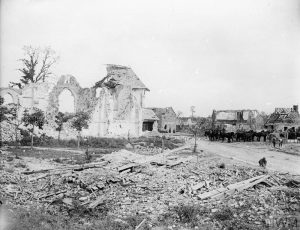Private John Stanley (born 1898) was killed two months from the end of the Great War. The location of the memorial and the date indicate that he was killed in the attack of the Drocourt-Queant line, and the follow up actions. The Drocourt-Queant (or DQ) line was part of the Hindenburg line. The Germans had withdrawn to this well prepared system of defences in the Spring of 1917. The Spring Offensive of 1918 saw them make large gains of territory very quickly. When the Allies managed to halt the offensive, the tide turned equally quickly.

It can be argued, with considerable justification, that the Generals took too long to learn lessons in the Great War. By 1918, considerable expertise had been accumulated on how to fight combined arms warfare. By this I mean the integration of tanks, artillery, motorised machine guns, cavalry, infantry and aircraft. Leaders such as the Canadian Sir Arthur Currie had proven track records of making significant advances. Indeed, the reputation of the Canadians was so high that great efforts were made to disguise their presence lest the Germans were given clues as to the point of the next attack.
The Canadians spearheaded the attack on the DQ line. The literature on the subject is dominated by the work of Canadian historians. They did not fight alone. They certainly did not die alone. John Stanley is one of 247 men from the Kings Own Yorkshire Light Infantry commemorated on the panels at Vis-en-Artois. There are 2344 graves at the Vis-en-Artois cemetery. Only 884 are tied in to a named soldier. There are 9836 names on the panels. These have no known grave. Some of them may be amongst the 1480 graves that simply say “A soldier of the Great War known unto God”. That still leaves a great number with no known resting place. The overwhelming majority (9818) of the names date from 5th August 1918 onwards.
The very high number of soldiers with no known grave, at this stage of the war, is slightly surprising. From 1914 to 1917, battles were often fought over very small portions of land. An attack was followed by a counterattack. Ground lost was promptly shelled by gunners who knew the exact coordinates. Artillery can easily destroy all landmarks. The same trench could change hands several times in a single battle. Casualties would be buried quickly, by whichever side was in control at the time. In these circumstances, it is hardly surprising that the location of particular graves would be subject to great uncertainty. By late 1918, the ebb and flow was largely (but not entirely) a thing of the past. If an advance stalled for any reason, then the point of attack would be changed. The pressure on the defenders was unrelenting. The Allies were, in the main, moving forward. This raises the question of why the location of so many casualties have been lost.
I wonder whether the location of a temporary graveyard was lost. After the War, the dead from small graveyards were often consolidated into much larger ones. Tyne Cot is the largest example of a cemetery that has been created from many smaller sites. I have no evidence. It is just a theory.
